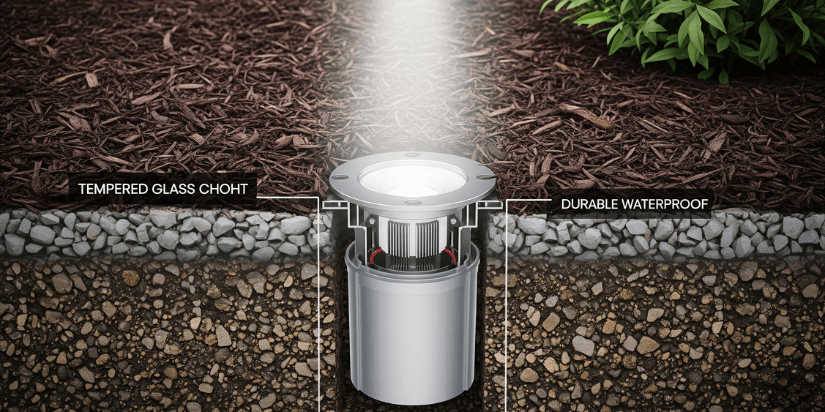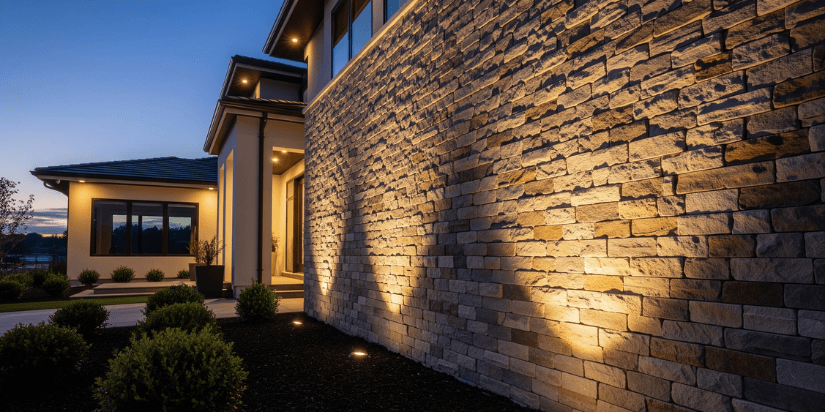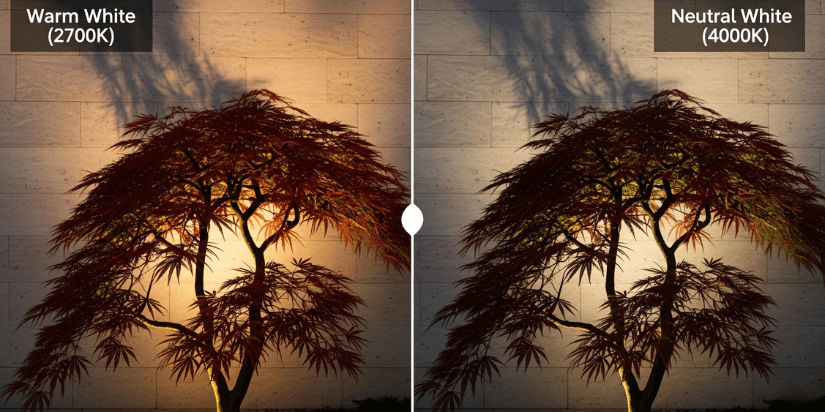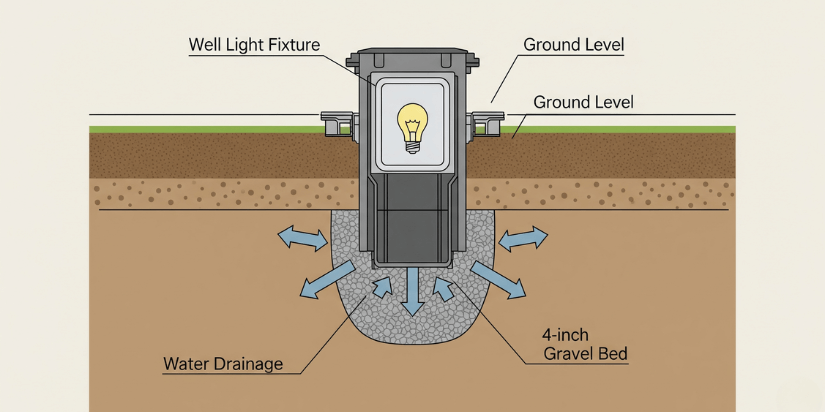Choosing the Right Inground Well Light: What to Look For!
Imagine, as dusk settles, your garden transforms into a breathtaking lighting scene. That majestic oak you had grown with your father is now glowing with a warm and golden light. But wait. Outsiders might think, "I can see the lighting, but where are the fixtures?" as they are unable to find a single visible one.
This is the magic of inground well lights, also known as recessed ground lights, or buried lights: Discreet powerhouses that deliver professional-grade uplighting, turning your landscape into a nighttime masterpiece.
If you want to set up this magical outdoor scene but don't know where to start, we are here to help!
This guide will cover the must-know technical details, aesthetic decisions, and installation tips to ensure your lights are as durable as they are beautiful. It is tailored for homeowners who want their outdoor spaces to shine; literally and figuratively.
What Exactly is an Inground Well Light?
An inground well light is a fixture tucked flush with or just below the ground, nestled in a protective sleeve or "well," designed to beam light upward. Think of it as a hidden artist, painting your landscape with light while staying out of sight. This low-profile design focuses on the effect: a softly lit tree trunk or a glowing pathway, without clunky hardware stealing the show.
The benefit of using inground lights is that they are installed underground. That means they will be invisible for:
Outsiders
Lawnmowers
Curious pets
They're built to withstand the elements, but only if you choose wisely, more on that later.
Common Applications
Inground lighting is your go-to for:
Uplighting towering trees, elegant fountains, or stately columns to create dramatic, eye-catching focal points.
Highlighting facades, bathing your home's exterior in a warm, inviting glow that screams curb appeal.
Guiding pathways or driveways, offering safe navigation with a subtle, sophisticated touch.
The Non-Negotiables: What Makes a Well-Lit Last
When you’re investing in inground well lights, durability is everything. These fixtures live in harsh conditions—rain, snow, or the occasional sprinkler blast—so cutting corners here is a recipe for disappointment. Let’s break down the must-haves.
| Specification | Description | IP Rating | Materials | Trade-Offs |
|---|---|---|---|---|
| Waterproofing & Durability | Water can damage wiring or fog lenses. Choose moisture-resistant fixtures. |
IP67: Handles temporary submersion (1m, 30 min). IP68: Ideal for water features or pooling areas. |
Housing: Type 316 stainless steel for corrosion resistance; brass for patina; aluminum may chip. Lens: Tempered glass (12mm+) for clarity; silicone for diffusion. |
Higher IP ratings cost more but prevent failures. Glass maximizes light but may stain; silicone may dim slightly. |
| Load-Bearing Capacity | Fixtures in walkways/driveways must resist weight to avoid cracking. | It is not applicable (IP rating is not relevant). | It is not applicable (material choice is less critical). | Heavy-duty models (2,500+ lbs/sq.in., up to 10,000kg for drive-over) are pricier but needed for traffic areas; lighter models (1,000+ lbs/sq.in.) save cost in low-traffic zones. |
| Heat Dissipation | Heat can degrade LEDs or cause fogging, reducing lifespan. | It is not applicable (IP rating is not relevant). | Fixtures with cooling features like cavities or fins. | Advanced cooling raises cost but extends life; cheaper models may fade faster. |
Creating the Perfect Effect: Crafting Your Nighttime Vision
Once you’ve nailed durability, it’s time to think about the vibe you’re creating. The right light can make your backyard feel like a cozy retreat or a grand estate. Here’s how to shape the effect.
| Specification | Description | Key Details | Trade-Offs |
|---|---|---|---|
| Beam Angle | Controls how light spreads, shaping the design’s aesthetic. |
Narrow Beams (15°-25°): Tight focus for slender features like cypresses or sculptures. Medium Beams (60°-90°): Wider glow for pathways or garden walls. Wide Beams (120°+): Floodlights for large facades or lawns. |
Narrow beams create drama but cover less area, so more fixtures are needed. Wide beams cover more but may lack focus, washing out details. |
| Color Temperature | Sets the mood with a light hue, measured in Kelvin (K). |
Warm White (2700K-3000K): Cozy, golden glow for patios or brick/stone textures. Neutral/Cool White (3500K-5000K): Crisp, modern look, enhances greenery or mimics moonlight. |
Warm light is intimate but may dull plant colors. Cool light boosts foliage vibrancy but can feel stark in social areas. Mixing temperatures can balance effects. |
| Glare Control | Prevents blinding light, keeping focus on the landscape. |
Frosted Glass Covers: Diffuse light for a soft, eye-friendly glow. Asymmetrical Optics: Angle light sideways for pathways/driveways. Recessed LED Modules: Shield light source for comfort and elegance. |
Frosted covers reduce glare but may dim output, requiring higher-lumen fixtures. Asymmetrical optics suit pathways but are less effective for uplighting tall features. |
Planning for Success: Installation Done Right
Even the best, well-lit ones won’t shine if poorly installed. Here’s how to set your lights up for long-term brilliance.
A. Drainage: The Unsung Hero
Water pooling around a fixture is a death sentence. Always dig 4 inches below the fixture to keep your lights safe and fill it with gravel. This creates a drainage bed that lets water flow away, protecting seals and wiring. A slight slope (about 2%) around the fixture helps redirect surface water.
B. Wiring and Connections
For low-voltage (12V) systems, bury cables 6-8 inches deep to keep them safe from shovels or critters. Use IP68-rated, gel-filled connectors to lock out moisture at every junction—think of them tiny waterproof fortresses for your wiring.
C. Spacing: The Art of Balance
For pathways, space lights 8-10 feet apart to create warm, inviting pools of light. Too close, and you’ll get a harsh, runway-like effect; too far, and the path feels dim and disjointed. For uplighting trees or walls, test placements at night to find the sweet spot where light and shadow dance perfectly.
Conclusion
Choosing the right inground well light is about blending bulletproof durability with a vision that makes your heart skip a beat. Start with the essentials: an IP67 or IP68 rating, a load-bearing capacity that matches your needs, and cooling features to keep things running smoothly. Then, shape the mood with the right beam angle, color temperature, a cozy patio glow, or a crisp garden spotlight. Finish strong with a rock-solid installation, and you’ve got a lighting system that’s as reliable as it is stunning.
Investing in quality well lights isn’t just about illumination; it's about crafting a nighttime experience that boosts your property’s beauty, safety, and value. So go ahead, light up your landscape like the masterpiece it is.






